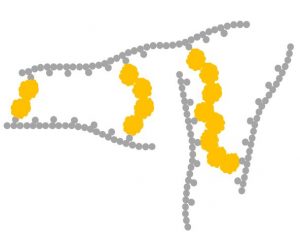Biomass-derived hybrid materials and composites
The project aim is the design and engineering of biomass-derived composites to substitute petroleum-based materials.
Upgrading recycled thermoplastics using cellulose oxalate for a more sustainable future
The absolute majority of plastic used today are fossil-based thermoplastics such as polypropylene and polyethylene. To an extent these plastics are recycled through mechanical recycling but the recycled plastic is mainly used for low-end, low quality products. This is due to decreased mechanical properties and due to that the recycled plastic often obtains a black […]
Catalytic functionalization of lignin
In this project we functionalize lignin using catalysts to form functional materials suitable for crosslinking to thermosets and/or composite materials.
Functional lignin nanomaterials
This is a umbrella theme of research carried out in Sustainable Materials Chemistry (SUSMATCHEM) research group in Stockholm University. We aim to make most out of lignin with minimal processing and chemical modification according to the principles of green chemistry. In addition to fundamental studies of structure and properties of lignin and lignin nanoparticles, we […]
A new sustainable route to polysaccharide hydrogel formation for medical and cosmetic applications
Hydrogels are an extremely versatile class of material, and have found relevance in cosmetic, medical, pharmaceutical, and industrial processes. A hydrogel has a low solid content, often comprising at least 90% water. Although hydrogels are increasingly used in cosmetics and drug manufacture, the production process is far from sustainable, relying on fossil-based polymers and chemical […]
Cross-linked protein-carbohydrate hydrogels

Using newly discovered carbohydrate-binding proteins, we are developing a novel method for hydrogel formation via biopolymer cross-linking.
Smuts, olje- och vattenavvisande träytor
Detta är ett Formasfinansierat projekt 2018-2022 som har en doktorand vid KTH i samarbete med RISE och nu med Karlstads universitet. Doktoranden Haiyan Yin licade i november 2020 och fortsätter till doktor. Hon har publicerat två arbeten hittills, ett i Materials and Design och ett i Holzforschung.
Renewable High-Performance Materials from the Forest with Designed Degradation – Next Generation of Plastic (Re-Design Plastic)
Sustainable material design can alleviate the environmental burden related to material waste. Use of available and abundant resources, create materials that can be recycled, and final degradability in nature is central to achieve this. The overarching aim of the proposal is to holistically design new materials from cellulose fibers by; developing new sustainable modification strategies, […]
Novel use of native cellulose in dispersions and functional biocomposites
This project supported by the FORMAS and Interreg Sverige-Norge specifically focuses on design and preparation of cellulose-based nanocomposites with added functionalities such as e.g. barrier, antimicrobial, catalytic and electronic properties, starting from water-based solutions of wood cellulose.
Expandable cellulose-based capsules
The development of expandable capsules holds a great promise for various advanced engineering applications. Preparation of such materials using renewable and sustainable resources is particularly attractive, where the development is driven by an increased global interest in new generations of green products that can meet the demands of the modern society. The aim of this […]
Study of the multiscale networks of hemicellulose hydrogels by scattering techniques
The aim of the project is to develop multifunctional soft materials (hydrogels) from hemicelluloses for biomedical and food applications. We combine chemo-enzymatic methods to modify the molecular structure of the hemicelluloses and to tailor their assembly and rheological properties. In this project we want to understand the assembly mechanisms that drive the gel formation upon […]
Biomassa från Salix för en biobaserad ekonomi
Målet med projektet är att studera alternativa användningsområden av biomassa från salix, t.ex. som råvara för produktion av biobränslen och av nya biokemikalier. Salix är en snabbväxande gröda med hög biomassaproduktion. För att förstå möjligheten att använda salix som råvara i olika processer behöver vi studera hela odlingssystemet hos salix inklusive både ovan- och underjordsprocesser. […]

